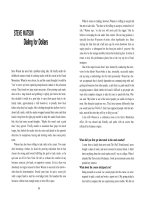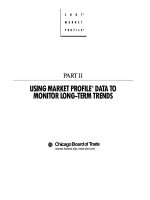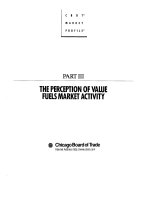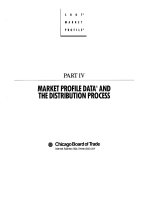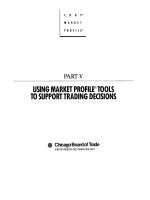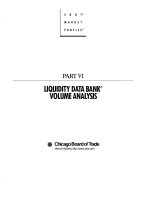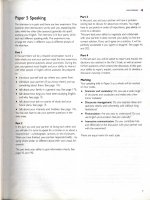A Six part study guide to Market profile Part 2 pps
Bạn đang xem bản rút gọn của tài liệu. Xem và tải ngay bản đầy đủ của tài liệu tại đây (1.35 MB, 42 trang )
C B O T®
MARKET
PROFILE ®
PART II
USINGMARKETPROFILE®DATATO
MONITORLONG-TERMTRENDS
0 ChicagoBoardofTrade
InternetAddresshttp://www,cbot.com
Care has been taken in the preparation of this material, but there is no warranty or representation expressed or
implied by the Chicago Board of Trade to the accuracy or completeness of the material herein.
Your legal counsel should be consulted concerning legal restrictions applicable to your particular situation which
might preclude or limit your use of the futures market described in this material.
Nothing herein should be construed as a trading recommendation of the Chicago Board of Trade.
01996 Board of Trade of the City of Chicago,
ALL RIGHTS RESERVED. Printed in the USA.
PARTI1: CONTENTS
USINGMARKETPROFILE®
DATATOMONITOR THELONG-TERMAUCTIONCHART 50
LONG-TERMTRENDS
TheFormat 50
TheLonger-termBehaviorPattern 59
ConstructingTheChart 63
InSummary 86
THELONG-TERMAUCTIONCHART
Part I of this Home Study Guide discusses activity in a single ses-
sion. In Part II, we're going to look at activity in longer-term
trends. Once again, we're going to focus on the longer-term trader
because, just as he determines how a single session develops, his
willingness to buy or to sell determines how long a major trend
lasts.
We're going to monitor his activity with the help of the long-term
auction chart.
TheFormat This longer-term graphic takes daily information on price, value and
market activity (the activity of the longer-term trader in the three
areas of the range-extremes, range extension, value area) and
PRICE organizes it visually.
The price range of the auction is in the center of the chart.
97 To the right of the price range, opposite the appropriate prices, are
30 rectangles representing the range of the daily value areas. This is the
28 VALUE
26 range in which 70°70of the day's trade occurred-in other words,
24 * ___" the first standard deviation. (Look at page 51 to see how the 70%
22
20 range is calculated.)
18
16 The wider the 70% range, the better the market is facilitating trade.
12 Why? When market participants feel confident about value, they
10 are willing to trade in a larger area.
O8
O6
o4 The rectangles representing value move up or down as the market
9602 trends up or down. As long as value is moving vertically, the auc-
30 tion or trend is continuing. In other words, the long-term range is
28 expanding up or down.
26
24
22 Steidlmayer's long-term format is vertical because price moves
20 vertically-up or down. The rectangles representing value move to
18
16 the right only if the auction stalls and the market starts to trade
14 sideways.
12
08 You can see at a glance whether value is moving up or down or if it
o6 is moving sideways.
O4
O2
95 That takes care of price and value. The other component of a long-
term trend is market activity.
5O
Why is market activity on the chart? It's not on other long-term
graphics such as bar charts, for example.
This chart shows the activity of longer-term buyers and sellers
because it is their activity that moves price up, down or sideways. In
the broadest terms, if an up trend is going to continue, you need
strong activity from the buyer. Conversely, if a down trend is going
to continue, you need strong activity from the seller.
See page 52. Daily information on longer-term buying activity in
the three areas of the range is on the right. Daily information on
longer-term selling activity in the three areas of the range is on the
left. (Since we're always discussing the longer-term buyer and seller's
activity, we're just going to use the terms buyer and seller from this
point on.)
70%
RangeCalculation Contracts Totalvolume555
10X 70%volume388
50XX
l xxx
XXXX
70°;0range 150XXXXX
70XXX
C 60XX
20X
15X
IOX
• To calculate the 70% range, start with the high volume price. If
that volume is 70% or more of the day's total, that's the range.
• If it is not, check the volume for the two prices above the high
volume price and the two prices below it. Take the larger of the
two. Add it to the original volume and continue in this manner
until you have 70% of the day's total volume.
• In this example, start with 150 contracts. Then compare the two
above with the two below. (80+90= 170 vs. 70+60= 130.) Take
170 and add it to 150. Continue until you have approximately 388
which is 70% of the day's total volume of 555 contracts.
• The 70% calculation generally is slightly greater than 70%.
Why? We're working with all the volume at a given price. We
would have to use fractions of the volume at each price to come
out with exactly 70%.
51
There are three columns for initiating activity (extremes, range
extension and value area) and three columns for responsive activity
(extremes, range extension and value area)-six columns for the
buyer and six columns for the seller.
We're going to represent market activity with boxes on the appro-
priate column. (To review briefly, initiating activity is buying above
value and selling below value; responsive activity is selling above
and buying below value.)
On the chart below, you can see that on day 1 there is initiating
buying in all three areas of the range. (The boxes are roughly oppo-
site the center of the day's value area.) Again on day 2, there is ini-
tiating buying in all three areas of the range. Then on day 3, along
with initiating buying in the range extension up and in the value
area, there is responsive selling on the high extreme.
The chart is organized with price and value in the center because
price and value form the auction core.
Extremes are closest to the core because, in general, extremes form
first in a session, any range extension next and the value area last.
Initiating activity is also closest to the auction core because it is
generally stronger than responsive activity.
SELLING BUYING
RESPONSIVEINITIATING INITIATING RESPONSIVE
o o o .o
_ _ _ _ _ PRICE _ _ _ _ _ :_
VALUE
EEE
6* 22 I 6
4 5* _ 4
._ , 3
3 _
o4 I
_ -
181
1(31 i
141
1_ _
O8
06 1
04
02
52
However, as you work with the data, you will see that initiating
activity is not always stronger than responsive activity. For example,
say you're at the top of a move and you have initiating buying that
is not facilitating trade. Volume is low; the value area is narrow.
This can be an indication that the move may be coming to an end.
In other words, the market may continue to move up but at a
decreasing rate.
Now say the market goes a little higher and brings in strong respon-
sive selling. The solid responsive activity (a strong opposite
response) could be an indication that the market may be getting
ready to reverse.
Look at the format again and you can see that we have the three
basic components of a trend-price, value and market activity-on
the chart. Now, we're going to add neutral days and failed range
extensions to the left of the price range with an asterisk.
First, let's define the terms.
Neutral days have range extension in both directions-range exten-
sion up and down-because market participants are uncertain.
A failed range extension shows that the market tried to extend the
range past the initial balance-at either end-and failed. After the
failure, the market generally retraces and extends the range on the
opposite side because, again, market participants are uncertain.
You know what a neutral day looks like because we covered neutral
days in Part I. (See page 18 in Part I.) What does a failed range
extension look like in the data?
It can appear in several ways. Keep in mind, though, that these are
just general guidelines. The issue here is to understand the concept-
not to focus on the number of ticks.
• A failed range extension can be one single print (see page 55).
• A failed range extension can be two to four single prints-in
other words, an extreme (see page 56).
• Or a failed range extension can be a double print at the top or
bottom of the range (see page 57).
What happened in all three cases?
The seller fails to bring in more selling with the attempt at range
extension. There is no follow-through. This is the key-no follow-
through activity after the initial attempt at range extension.
Well, that's what neutral days and failed range extensions look like
in the data. How do you indicate this kind of activity on the chart?
Since there is generally no net influence on neutral days, we're just
going to put an asterisk to the left of the price range opposite the
day's value area. We're not going to indicate activity in other parts
of the range with boxes. See page 52. Day 5 is a neutral day.
We don't indicate activity with boxes because the market is gen-
erally balanced on neutral days. As you start to work with the data,
however, you'll see that the market sometimes starts out balanced
on neutral days and then begins something new in the same session.
53
Activity on page 66 is an example of the market coming into
balance with range extension in both directions and then beginning
something new in the same session. Or the market might test the
upside with a range extension, then trade back and begin something
new with a range extension to the downside.
As you move forward, you'll see that the critical issue is recognizing
whether the market is still balanced and moving sideways on the
neutral day or if it has become imbalanced and is starting to
trend.
As far as the chart is concerned, we're going to indicate all neutral
days just with an asterisk to the left of the price range.
On the other hand, when we see a failed range extension, we're
going to note the failure with an asterisk and we are going to indi-
cate activity in other areas of the range with boxes. Why? Because a
failed range extension on the upside is defined by longer-term range
extension on the downside or vice versa. See page 55.
To understand this concept, think of the traders most in touch with
the market: the short-term locals who provide liquidity by making a
market. If they are going to stay in business, they have to anticipate
market direction. Occasionally, this intuitive sense encourages them
to do too much too soon. The result: an opportunity that no one
wants-in other words, a failed range extension.
See page 52. Day 6 has a failed range extension down.
The asterisk indicates the failure; the boxes show range extension up
and buying in the value area.
You know the asterisk reflects a failed range extension and not a
neutral day because there are boxes reflecting activity for day 6. You
also know the failure was to the downside because one of the boxes
shows that the buyer successfully extended the range up.
Both kinds of activity-neutral days and failed range extensions-
show a failure in the session by the longer-term trader. If this activ-
ity is a failure, why is it on the longer-term chart? Because neutral
days and failed range extensions often have longer-term implications.
The market often uses neutral days to change direction. Failed
range extensions often indicate that the market wants to go in that
direction but is trying to do too much too soon.
Nevertheless, since both kinds of activity indicate uncertainty, it
isn't always going to be clear if you have a neutral day or a failed
range extension. So you'll have to use judgment. In order to under-
stand what's happening, it helps if you ask yourself whether the
market is trying to do too much too soon , or if it is testing one
more time before changing direction.
It doesn't matter what you put on the chart. The critical issue is to
read what the market is telling you correctly.
See the example on page 58.
54
MarketFailure Market Profile®Graphic
MARKETPROFILE® CopyrightChicagoBoard of Trade1988.
SOYBEANS Mar (88) ALL RIGHTS RESERVED.88/03/14
TradePrice HalfHourBracketTimes
616 K
6153/4 K
615I/2 K
615I/4 K
615 K
6143/4 K
6141/2 K
6141/4 K
614 K
6133/4 K
613112 K
6131/4 JK
613 JK
6123/4 JK
6121/2 JK
6121/4 JK
612 DEJK
6113/4 DEHJ
6111/2 DEHIJ
6111/4 DEHIJ
611 DEFHIJ
6103/4 Initial DEFHIJ
6101/2 balance DEFGHIJ
6101/4 DFGHIJ
610 DFGHI
6093/4 DFGI
6091/2 DFGI
6091/4 DFG
609 DG Failed range
6083/4 G_ extension
• The failure on the downside is defined by range extension on
the upside.
• Generally, after a failed range extension, you'll have range exten-
sion in the opposite direction-but not always. Once again, the
issue is whether the market is trying too much too soon-not
whether this is technically a failed range extension.
55
MarketFailure
ac
Range abe
extension Xabc
Xabc
up Xabc
Xabc
T TWXabc
T TWXab
T TWXab
T Initial TWXb
Initial TUW balance TUWX
balance TUVW TUVW
TUVW TUVW
TUVW TUVW
TUVW TUVW
TUV TUV
V Failed range V
V extension V
V down V
• The soybean market is trading opposite the initial balance. Then
in V period, the seller tries to extend the range down. He extends
it three ticks but the range extension fails because the buyer
comes in right away.
• Then the market trades all the way back and the buyer extends
the range up in X period. The range extension continues in the a
period.
56
MarketFailure Market Profile ®Graphic
MARKET PROFILE ® Copyright Chicago Board of Trade 1991.
SOYBEANS May (91) ALL RIGHTS RESERVED. 91/03/22
TradePrice HalfHourBracketTimes
580 Xc
5793/4 Xbc
5791/2 Xbc
5791/4 Xabc
579 Xabc
5783/4 Xabc
5781/2 Xabc
5781/4 Xabc
578 Xabc
5773/4 Xabc
5771/2 Xabc
5771/4 Xc
577 TXc
5763/4 TX
576!/2 TUWX
576!/4 TUWX
576 TUWX
5753/4 TUW
575!/2 TUW
5751/4 Initial TUW
575 balance TUW
5743/4 TUVW
5741/2 TUVW
5741/4 TUVW
574 TUVW
5733/4 TUVW
5731/2 TVW
5731/4 TVW
573 TVW Failed range
572 3/4 VW extension
57
MarketFailure Market Profile ®Graphic
MARKET PROFILE ® Copyright Chicago Board of Trade 1990.
U.S. BONDS Dec (90) ALL RIGHTS RESERVED. 90/10/11
TradePrice HalfHourBracketTimes
89 _ t Failed range
8831/32 extension up
8830/32 ST or neutral day?
8829/32 QRSTW
8828/32 QRSTW
8827/32 QRSTUWX
8826/32 Initial PQRSTUWX
8825/32 balance OPQRTUWXa
8824/32 OPTUVWXa
8823/32 OPTUVWXa
8822/32 OPUVWXa
8821/32 OUVWXa
8820/32 UVa
8819/32 Vab
8818/32 ab
8817/32 ab
8816/32 b
8815/32 b
8814/32 b
8813/32 bc
8812/32 bcd
8811/32 bed
8810/32 bed
88 9/32 bed
88 8/32 bed
88 7/32 bc
88 6/32 bc
88 5/32 b
• Is the S period extension one last test of the upside or does the
market want to go in that direction? In other words, is this a
neutral day or a failed range extension on the upside? It's impos-
sible to tell just by looking at the data.
• Ask yourself: Where are you in the move? What are the current
conditions that affect value? Why is the longer-term trader
uncertain? These questions will help you focus on the context in
which the activity is occurring.
58
I
TheLonger-term
BehaviorPattern Nowthat we have a format, what are we going to look for on the
chart? We examined daily activity in terms of imbalance and
balance and we are going to use the same behavior pattern to
monitor long-term trends.
Specifically, the behavior pattern is 1) imbalance, 2) balance, 3) test
and 4) imbalance in the same direction or imbalance in a new direc-
tion. You'll see this pattern clearly as we construct a long-term auc-
tion chart.
Before we begin, though, let's look for this pattern on page 52.
Days 1 and 2 are imbalanced. Value is moving vertically. Buying is
the dominant activity. Boxes representing activity are only on the
buy side of the chart.
Then, on day 3 the market is high enough to bring in an opposite
response. Responsive selling on the high extreme is an indication
that the market may be starting to come into balance.
On day 4, the market is moving sideways. The market has moved
from imbalance to balance-from a situation where boxes were on
one side to one where they are on both sides.
Day 5 is a neutral day. The market is balanced. It seems to be
testing the strength of the up move.
On day 6, value is still unchanged but there is a failed range exten-
sion to the downside. This could be an early indication that the
market wants to go in that direction. The market seems to be con-
tinuing to test. If the seller gains confidence, however, this might be
the end of the up move and the beginning of a down move. In other
words, the market could become imbalanced in a new direction.
One more point before we start constructing the chart.
The behavior pattern discussed above is a constant. However, when
the market comes into balance , how long it tests , and whether it
becomes imbalanced again in the same direction or in a new direc-
tion depend on a variable- the perception of value.
Therefore, in real life we wouldn't be reading this chart in a
vacuum. We would be constantly evaluating activity in relation to
the conditions that affect value.
We're going to add the perception of value to our analysis in Part
III. For now, we're just going to focus on learning to identify the
market's imbalance-balance behavior pattern with the help of the
long-term auction chart.
Before we start constructing the chart, however, stop and test
yourself on the material we've covered so far. The test is on page 60.
59
StopAndTestYourself
Q. What are the components of a long-term trend?
A. Price, value and market activity.
Q. Why is market activity on the long-term chart?
A. Because it is market activity (activity of the longer-term trader
in the three areas of the range) that moves price up, down or
sideways.
Q. Why is activity on the chart organized with extremes closest to
value, range extension next and activity in the value area
furthest?
A. In general, extremes form first in a session, range extension
next and the value area last.
Q. Why are neutral days and failed range extensions on the long-
term chart?
A. Even though this kind of activity is a failure in the session, it
often has longer-term implications.
Q. What do neutral days and failed range extensions indicate?
A. Uncertainty.
Q. Is it always going to be easy to determine if you're dealing
with a neutral day or with a failed range extension?
A. No, because both kinds of activity indicate some uncertainty
about longer-term value.
Q. What can you ask yourself to make the decision less difficult?
A. Is this activity one last test of the upside or downside before
reversing , or does the market want to go higher or lower but is
trying to do too much too soon? It helps to relate these questions
to the current perception of value.
Q. What behavior pattern are we looking for in the chart?
A. Imbalance, balance, test, imbalance in the same direction or
imbalance in a new direction.
Q. Is this pattern a constant?
A. Yes, the behavior pattern is a constant but the length of time
any part of the pattern lasts depends on a variable.
Q. What is the variable?
A. The perception of value.
60
9/12/86 to construct our chart. Use the blank form on page 62.
There is a completed long-term chart on page 89 against which you
can check your work.
As noted in the introduction, we're using data from 1986 because
these sessions are especially illustrative of the market's imbalance-
balance behavior pattern.
To set the scene: this is the end of August 1986. We're at the top of
an up move. At the beginning of the month, the market was trading
at 95-15. On 8/28/86, value was 101-05 to 100-16.
The long-term unfair high parameter was established in April 1986
at the 105-00 level and we're approaching it again. As noted earlier,
these parameters are reference points because they can contain the
range. The market either trades through the parameter or reverses.
With that in mind, let's look at activity on 8/29/86. The text is on
page 64; the data is on page 65.
63
8/29/86 Where did the market open in relation to the previous day's value
area and then what happened?
The market opens above value at 101-30 to 102 and moves down,
creating a selling extreme at the top. The buyer comes in at 101-14
and the market trades up and tests the upside in C and D periods.
It can't trade up and gradually rotates down in E, F and G periods.
Then what happens in H? In H period, the seller extends the range
down.
Since there is no follow-through activity, would you say this is a
failed range extension? Remember, we're at the top of the move.
Does the market seem to want to reverse? In other words, is the
market trying to do too much too soon?
There is no follow-through activity because the buyer enters the
market and his competition forms an extreme at the low. Then the
market rotates between the high A period extreme and the low H
period extreme-developing value for the rest of the session.
First, put the price range on the chart. Start with 102-00 at the top
and come down by two's (102, 101-30, 101-28, etc.).
Next, put the day's value area (70% range) on the chart opposite
the appropriate prices, 101-22 to 102.
Note the volume in the column on the right.
You can use total volume for all contracts traded or volume for the
specific contract you are trading. Just be consistent so that you can
see whether the volume is increasing or decreasing. We're looking at
volume because a move that brings in increasing volume generally
has to go higher or lower to shut off the activity.
What is the net activity in the session- extremes, range extension,
value area? Initiating or responsive?
Responsive selling above the previous day's value on the high
extreme, initiating buying above the previous day's value on the low
extreme, failed range extension down, initiating buying above the
previous day's value in today's value area.
Let's put that activity on the chart.
What is your conclusion ?
We're approaching a parameter. What kind of activity from the
buyer do we need to trade above the high parameter? Are we get-
ting it? Is the initiating buying facilitating trade? Simply put,
facilitating trade means that as the price moves up, the move brings
in more buying or as the price moves down, the move brings in
more selling. Is the up move here bringing in substantial volume?
64
8/29/86 Chicago Board of Trade Liquidity Data Bank _ Report
Copyright Chicago Board of Trade 1986. ALL RIGHTS RESERVED.
Volume Summary Report for 08/29/86
U.S. Bonds
Dec 86
Note: Volume figures shown are actual numbers multiplied by 2.
TradePrice HalfHourBracketTimes
02 A
O131/32 A
0130/32 A Responsive selling high extreme
O129/32 A
0128/32 A
0127/32 A
0126/32 AL
O125/32 ACDL 13 TPOs
0124/32 ABCDEKL
_101 23/32 _rgEF_,_L Initiating buying
0122/32 ABCEFGJKLin value area
0121/32 BCEFGJKL
0120/32 BCEFGHJ
0119/32 BCFGHJ 50 TPOs
OI18/32 BCFGfllJ
0117/32 BHIJ
0116/32 BHIJ
0115/32 BHJ
0114/32 BH
O113/32 H_
01 12/32 Initiating buying low extreme
01 11/32
70% range 10122132 Failed range extension down
of daily to
volume 102
Value area
Total Volume % of Total
I CTI1 CTI2
Total Volume for Dec 86 U.S. Bonds 62,308 47.6 7.6
Total Volume for U.S. Bonds 252,318 54.7 11.5
Not only is the volume low but there is also a selling extreme at the
top. If we're going to trade through the parameter, we need strong
activity from the buyer and the buyer doesn't enter the market until
late in the session-H period.
This is an example of initiating activity not facilitating trade.
Also, a failed range extension is often an early indication that the
market wants to go in that direction.
Where do you think we are in the behavior pattern? It seems as
though the market is coming into balance and testing the high of
the move. The up auction may be coming to an end.
65
9102186 Chicago Board of Trade Liquidity Data Bank _ Report
Copyright Chicago Board of Trade 1986. ALL RIGHTS RESERVED.
Volume Summary Report for 09/02/86
U.S. Bonds
Dec 86
Note: Volume figures shown are actual numbers multiplied by 2.
TradePrice HalfHourBracketTimes
10120/32 E
10119/32 E
10118/32 EG
10117/32 EFGH
10116/32 EFGH
10l 15/32 EFGH Range extension up
10114/32 AEFGH
10113/32 AEFGHI
10112/32 AEHI
10111/32 ADEHI
10110/32 ABCDHIJNeutral day
101 9/32 ABCDHIJ
101 8/32 ABCDHIJ
101 7/32 ABCDIJK
101 6/32 ABCIJK
101 5/32 ABCIJKRange extension down
101 4/32 CIK
101 3/32 CK
101 2/32 CK
101 1/32 CK
101 K
10031/32 K
10030/32 K
10029/32 K
10028/32 K
10027/32 KL
lO026/32 KL
10025/32 KL
10024/32 KL
10023/32 L
10022/32 L
I0021/32 L
10020/32 L
10019/32 L
10018/32 L
10017/32 L
10016/32 L
10015/32 L
10014/32 L
10013/32 L
10012/32 L
10011/32 L
10010/32 L
100 9/32 L
100 8/32 L
100 7/32 L
100 6/32 L
100 5/32 L
100 4/32 L
100 3/32 L
100 2/32 L
100 1/32 L
100 L
9931/32 L
9930/32 L
9929/32 L
9928/32 L
9927/32 L
9926/32 L
9925/32 L
9924/32 L
9923/32 L
70% range _['_028/32
of daily lto Value area
volume [10120/32
Total Volume %of Total
t CTI1 CTI2
Total Volume for Dec 86 U.S. Bonds 235,820 54.3 11.8
Total Volume for U.S. Bonds 284,028 52.5 11.4
66
9/02/86 Where did the market open in relation to the previous day's value
and then what happened?
The market opens below value at 101-14 to 101-07 and trades down
initially. The seller extends the range down in C period. There is no
follow-through activity because the buyer enters and his competi-
tion forms an extreme at the low. The market then trades up and
tests the upside.
The buyer extends the range up to 101-20 in E period. This is just
below the bottom of the previous day's value area.
You've probably noticed how the market bounces off the tops and
bottoms of value areas. The tops and bottoms are ending distribu-
tions that can contain the range (in other words, stop a move). The
value area is the first standard deviation. In a larger sample size, the
top or the bottom of the value area is the end of the first standard
deviation and the beginning of the second.
Back to our example, the up move stops just below the parameter.
What are the only two things that can happen here? The market
can trade through or reverse. What happened in this session?
The market can't seem to facilitate trade at the top. The seller enters
at 101-20 and his competition forms an extreme.
What's happening in the market now? It is gradually trading lower.
The market rotates down in G, H and I periods. Value seems to be
shifting from the middle of the range down to the unfair low. In
other words, the market seems to be shifting from balance to
imbalance.
The balanced distribution started to come to an end in H period
and the market started to shift to imbalance in I.
Relating this activity to the longer-term move, the market tested the
upside again and failed to trade through the parameter. The buyers
don't seem to have gained confidence as far as the long-term move
is concerned.
What do you think about putting on a short position here?
In K period, the market takes out the low parameter (the C period
extreme) and trades down to 99-23 in L period.
Put value area on chart. Note the volume.
What is the net activity in the session ?
Range extension in both directions. What kind of day do we have?
Neutral day. Let's note the neutral day with an asterisk.
What is your conclusion ?
The up auction seems to be ending and a down auction beginning.
We are at a long-term unfair high (long-term parameter). The
market tested at the top of the move and couldn't trade up.
6"/
Activity was relatively easy to read in this session because the
market not only tested the upside but also began the new move
down in K period. This session is a clear example of the market
changing direction on a neutral day.
In this situation, the market had come into balance at the top of
the move. And it is always important to keep in mind that a bal-
anced market is in position for a directional move.
The market comes into balance because market participants are
uncertain. They're taking stock before they move directionally
again. That's why a balanced market gives you time to make a
decision.
Of course, the balance period can be extremely brief. And the shift
from balance to imbalance (or vice versa) is naturally going to
occur more frequently in active markets than it will in slow ones. In
this session, however, note the amount of time the market took to
shift from balance to imbalance.
The market tested the upside in E period and then gradually shifted
down in F, G, H, I, J. You had two and one-half hours while value
moved down from the middle of the range to the unfair low. The
market began to tip in K period and then became strongly
imbalanced in L.
Also, when you're at a parameter, you want to be aware of potential
liquidation.
Keep in mind that as soon as traders put on a position, they start
looking for a place to offset. Broadly speaking, if the market moves
against them, they are likely to offset and this activity can start a
market reversal. In this situation, we were at the top of the move
and market participants were long.
Finally, it is critical to recognize that the market is not always going
to test exactly as it did in this session. Nevertheless, if you know the
behavior pattern you're working with - imbalance, balance, test,
imbalance in the same direction or imbalance in a new direction-
you'll have a constant framework to anchor your judgments.
That's why it's so important to understand the basic principles and
not just to memorize rules. When you grasp the concept, you can
take it into any situation and recognize what is happening at that
particular time.
68
NOTES
69
9/03/86 Where did the market open in relation to the previous day's value
area and then what happened?
The market opened almost two points lower at 98-21 to 98-24. It
initially tested the top and then moved down directionally. It found
an opposite response at 98-08 in B period and then traded back up
in C and D periods.
The market started to rotate down in E period. In F period, the
seller tipped the initial balance and extended the range. He extended
it again in H period down to 97-13.
What happened then?
The directional move took the market low enough to bring in
stronger buying. The buyer's competition created a five tick single
print extreme that stopped the move and the market traded back up.
Put value area on chart. Note the volume.
What was the net activity in the day-extremes, range extension
value area? Initiating or responsive?
No extreme at the top (just one single tick), responsive buying
below the previous day's value on the low extreme, initiating range
extension down below the previous day's value, initiating selling
below the previous day's value in today's value area.
Let's put that on the chart.
What is your conclusion? Do you think this is just a pause in the
down move? Or do you think the market is going to reverse?
We've moved down far enough to bring in an opposite response.
Buying and selling are both present. So it appears that we've moved
from 1) imbalance to 2) balance.
There is substantial range extension down. The range extension is
about double the initial balance. So even though it extended low
enough to bring in strong buying, the seller still seems to be actively
interested.
We're going to discuss Liquidity Data Bank volume in Part VI of
this Home Study Guide. I want to point out here, however, that by
looking at the percent of total column opposite the H period
extreme, you can see how fast the market moved out of the area.
(The percent of total column shows the percent of the day's total
volume at each price. The lower the volume, the faster the market is
moving.)
What do you want to do about your position ?
We'll have to monitor activity, of course. But it wouldn't be
unreasonable to anticipate that the market will probably test
tomorrow-in other words, step three in the behavior pattern.
70
9103186 Chicago Board of Trade Liquidity Data Bank _ Report
Copyright Chicago Board of Trade 1986. ALL RIGHTS RESERVED.
Volume Summary Report for 09/03/86
U.S. Bonds
Dec 86
Note: Volume figures shown are actual numbers multiplied by 2.
% of
TradePrice Total Half HourBracketTimes
9830/32 2.3 A
9829/32 1.8 AB
9828/32 2.7 AB
9827/32 3.2 AB
9826/32 3.2 AB
9825/32 2.2 AB
9824/32 2.7 AB
9823/32 3.6 ABD
9822/32 2.7 ABDE
9821/32 2.5 ABDE
9820/32 4.9 ABCDE
9819/32 2.9 ABCDE
9818/32 1.7 ABCE
9817132 2.0 ABCE
9816/32 1.4 BCEL 93 TPOs
9815/32 2.6 BCEL
9814/32 3.3 BCEL
9813/32 1.3 BEFL
9812132 0.4 BEFL
9811132 1.1 BFL
9810132 2.4 BFKL
989/32 2.1 BFKL
98 8/32 3.3 BFKL Range extension down
987/32 2.7 FKL
986/32 2.1 FKL initiating selling
985/32 1.3 FKL
984/32 1.1 FIKL
983/32 2.1 FIKL
_-98 2/32 1.8 ,_G,,j,_,L Initiating selling
981/32 1.6 FGIJK in value area
98 3.8 FGIJK
9731/32 3.6 FGHIJK
9730/32 3.1 FGHIJK
9729/32 2.7 FGHIJK
9728/32 1.9 FGHIJ
9727/32 2.7 FGHIJ 67 TPOs
9726/32 2.3 FGHIJ
9725/32 2.3 FGHIJ
9724/32 1.8 FGHIJ
9723/32 1.1 FHI
9722/32 0.4 FHI
972i/32 0.5 HI
9720/32 0.3 HI
9719/32 0.6 HI
9718/32 1.7 HI
9717/32 0.9 H
9716/32 Low 0.4 H
0.6 H Responsive buying low extreme
979714/3215/32volume 0.5 H
9713/32 0.0 H
70°7o range [ 98
of daily [ to ABCDEFGIJKL
volume 9830/32
"' Value area
Total Volume °7oof Total
I CTI1 CTI2
Total Volume for Dec 86 U.S. Bonds 457,474 55.0 12.5
Total Volume for U.S. Bonds 508,740 54.5 12.6
71
9/04/86 Where did the market open in relation to the previous day's value
and then what happened?
The market opens at 98-14 to 98-17-in the previous day's value-
and then trades up in B period. It can't trade above 98-26 and
trades down in C period.
In D period, the seller tips the initial balance and extends the range
down. The range extension stops in F period at 97-17 but there is no
competition from the buyer to form an extreme.
The market rotates back up in G, H, I and J and then down in K
and L periods.
Put value area on the chart. Note the volume.
What is the net activity in the session- extremes, range extension
value area? Initiating or responsive?
No extreme at the top (no single prints), no extreme at the bottom
(just one single print), initiating range extension down mostly below
the previous day's value, initiating selling within the previous day's
value in today's value area.
(Activity within value is a judgment call. You can classify it as
either responsive or initiating. Calling it responsive because it is
weak or calling it initiating and noting that the activity is not
facilitating trade gives you the same information on market activity.
To simplify this exercise, we're going to call all activity within value
initiating. In addition, if activity is below and within value or above
and within value, we're going to call it initiating.)
Getting back to our example, let's put the activity on the chart.
What is your conclusion ? Was the buyer strong enough to do
anything to the market in the session ?
There is no net buying. Selling activity and volume seem to indicate
that the market is still imbalanced to downside. It appears that the
market has to move lower to bring in the last seller (i.e., shut off
selling activity) and to bring in buying strong enough to stop the
down move.
Therefore, it appears that the down move is continuing but
perhaps at a decreasing rate.
72

